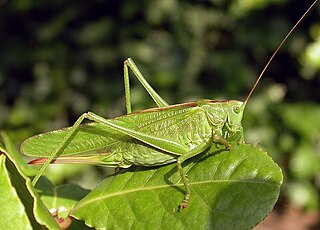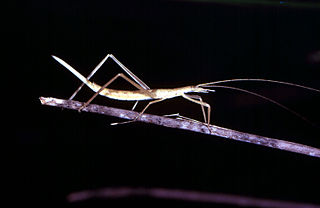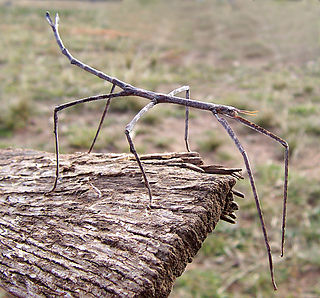
The Cooloola monster is a large burrowing orthopteran of the family Cooloolidae, a family erected to accommodate it because it is so dissimilar to other ensiferans. It was discovered in 1980 in the Great Sandy National Park in Queensland, Australia, by David C. Rentz. Further members of the genus Cooloola were later discovered at other locations in Queensland.

The Tettigoniinae are a subfamily of bush crickets or katydids, which contains hundreds of species in about twelve tribes.

The Phasmatidae are a family of the stick insects. They belong to the superfamily Anareolatae of suborder Verophasmatodea.
Conozoa hyalina, the California Central Valley grasshopper or just Central Valley grasshopper, was a species of grasshopper in the family Acrididae, now extinct. It was endemic to the United States.
Ixalodectes is a genus of Australian bush crickets.

Kawanaphila is a genus of insects in family Tettigoniidae from Australia. It was described in 1993 by David C. Rentz.
Ammopelmatus navajo, commonly known as the Navajo Jerusalem cricket, is a species of nocturnal Jerusalem cricket in the family Stenopelmatidae. It is endemic to the United States, specifically Arizona, and found under rocks in loose soil. It is closely related to A. fuscus and they have nearly identical drumming patterns. They live one to two years as adults, but can die prematurely by parasitic infections, commonly by the horsehair worm.
Throscodectes is a genus of Australian bush crickets.
Trimerotropis occulens, the Lompoc grasshopper, is a species of grasshopper in the family Acrididae. It is endemic to the United States.

Gryllacrididae are a family of non-jumping insects in the suborder Ensifera occurring worldwide, known commonly as leaf-rolling crickets or raspy crickets. The family historically has been broadly defined to include what are presently several other families, such as Stenopelmatidae and Rhaphidophoridae, now considered separate. As presently defined, the family contains two subfamilies: Gryllacridinae and Hyperbaeninae. They are commonly wingless and nocturnal. In the daytime, most species rest in shelters made from folded leaves sewn with silk. Some species use silk to burrow in sand, earth or wood. Raspy crickets evolved the ability to produce silk independently from other insects, but their silk has many convergent features to silkworm silk, being made of long, repetitive proteins with an extended beta-sheet structure.

Ctenomorpha marginipennis, the margin-winged stick insect, is a species of stick insect endemic to southern Australia. The species was first described by George Robert Gray in 1833.

Alfredectes is a genus of bush crickets or katydids, which is endemic to South Africa.

Agraeciini is a large tribe of bush crickets or katydids in the conehead subfamily, Conocephalinae.

Paraphisis is a genus of bush crickets in the subfamily Meconematinae.
Microtettigonia is a genus of bush-crickets or katydids, endemic to Western Australia and known as micro katydids. It is the only genus of the subfamily Microtettigoniinae.

Zaprochilinae is a subfamily of bush-crickets found in Australia; the type genus is Zaprochilus.

Austrosaginae, the sluggish katydids, are a subfamily of Australian insects within the family Tettigoniidae.
Trimerotropis occidentiloides is a species of band-winged grasshopper in the family Acrididae. It is found in North America.
Austrophlugis is a genus of bush crickets or katydids belonging to the tribe Phlugidini. The species of this genus are found in Australia.

Alectoria superba is a species of Australian bush crickets or katydids in the subfamily Phaneropterinae. It is the only species in the monotypic genus Alectoria. The genus is placed in the genus group Ephippithytae; both genus and species were described in 1879 by Carl Brunner von Wattenwyl.












